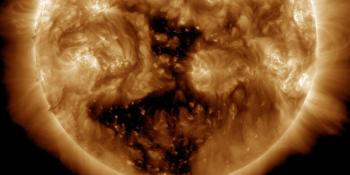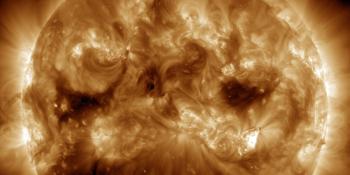Viewing archive of Tuesday, 17 July 2012
Solar activity report
Any mentioned solar flare in this report has a scaling factor applied by the Space Weather Prediction Center (SWPC). Because of the SWPC scaling factor, solar flares are reported as 42% smaller than for the science quality data. The scaling factor has been removed from our archived solar flare data to reflect the true physical units.
Report of Solar-Geophysical Activity 2012 Jul 17 2200 UTCPrepared by the NOAA © SWPC and processed by SpaceWeatherLive.com
Joint USAF/NOAA Report of Solar and Geophysical Activity
SDF Number 199 Issued at 2200Z on 17 Jul 2012IA. Analysis of Solar Active Regions and Activity from 16-2100Z to 17-2100Z
Solar activity was moderate. Todays activity was
dominated by a very long-duration M1 flare that occurred between
1203-1904Z with maximum at 1715Z. The source region appeared to
primarily be Region 1520 (S17W75), although it appears that Region
1521 (S19W85) was involved in the early phase and may have been the
initial trigger for the overall event. An associated, bright CME was
observed off the southwest limb beginning at 1400Z; the leading edge
plane-of-sky speed was estimated to be about 960 km/s in the LASCO
C3 field of view. The proximity of Regions 1519 (S17 just past west
limb), 1520, and 1521 to the west limb hindered analysis of the spot
groups. New Region 1524 (S18E52) was assigned and is a simple C-type
sunspot group. An additional new spot group appeared to be emerging
just south of Region 1524.
IB. Solar Activity Forecast
Solar activity is expected to be
moderate for the next 24 hours with 1520 and 1521 as the most likely
source regions. Activity and background levels are expected to
decrease significantly by the second and third days as these regions
rotate beyond west limb.
IIA. Geophysical Activity Summary 16-2100Z to 17-2100Z
The geomagnetic field ranged from active to quiet levels with some
isolated minor and major storm intervals at high latitudes.
Unsettled to active levels prevailed duing the earlier part of the
period and quiet to unsettled levels dominated from 17/0900Z through
the end of the day. Solar wind observations from the ACE spacecraft
showed continued influence of the 12 July CME from the beginning of
the period through about 17/0600Z. The z-component of the
interplanetary magnetic field was initially negative and reached a
peak negative value of about -9 nT during this latter phase of the
CME passage. Nominal solar wind conditions prevailed from 17/0600Z
through the end of the day. A greater than 10 MeV proton event began
at 17/1715Z in response to todays long-duration M1 and associated
CME event. The peak value observed so far was 87 PFU at 17/2030Z.
The greater than 2 MeV electron flux at geosynchronous orbit reached
high levels during the period.
IIB. Geophysical Activity Forecast
The geomagnetic field is
expected to be quiet for the next three days. Model results for
todays CME from the west limb indicate an interplanetary
disturbance that is too far west to produce geomagnetic activity.
The greater than 10 MeV proton event is expected to continue through
part of the first day (18 July).
III. Event Probabilities 18 Jul to 20 Jul
| Class M | 55% | 40% | 25% |
| Class X | 10% | 10% | 05% |
| Proton | 95% | 20% | 05% |
| PCAF | yellow | ||
IV. Penticton 10.7 cm Flux
Observed 17 Jul 128 Predicted 18 Jul-20 Jul 115/105/095 90 Day Mean 17 Jul 129
V. Geomagnetic A Indices
Observed Afr/Ap 16 Jul 027/040 Estimated Afr/Ap 17 Jul 015/020 Predicted Afr/Ap 18 Jul-20 Jul 006/005-007/005-006/005
VI. Geomagnetic Activity Probabilities 18 Jul to 20 Jul
| A. Middle Latitudes | |||
|---|---|---|---|
| Active | 05% | 05% | 05% |
| Minor storm | 01% | 01% | 01% |
| Major-severe storm | 01% | 01% | 01% |
| B. High Latitudes | |||
|---|---|---|---|
| Active | 15% | 15% | 15% |
| Minor storm | 10% | 10% | 10% |
| Major-severe storm | 05% | 05% | 05% |
All times in UTC
Latest news
Latest forum messages
Aurora photography hints for those of us with smartphones 44Incoming & Unnumbered Active Regions 1644AR4043 17Large Coronal Hole 25 152Photographing auroras 36
More topicsSupport SpaceWeatherLive.com!
A lot of people come to SpaceWeatherLive to follow the Sun's activity or if there is aurora to be seen, but with more traffic comes higher server costs. Consider a donation if you enjoy SpaceWeatherLive so we can keep the website online!

Space weather facts
| Last X-flare | 2025/02/23 | X2.0 |
| Last M-flare | 2025/03/27 | M2.0 |
| Last geomagnetic storm | 2025/03/26 | Kp6+ (G2) |
| Spotless days | |
|---|---|
| Last spotless day | 2022/06/08 |
| Monthly mean Sunspot Number | |
|---|---|
| February 2025 | 154.6 +17.6 |
| March 2025 | 132.3 -22.3 |
| Last 30 days | 131.2 -21.8 |


